Management and Organizations: Teamwork, Tuckman’s Model and Leadership
VerifiedAdded on 2023/06/12
|14
|3696
|155
Report
AI Summary
This report delves into the concepts of team and teamwork within the contemporary business landscape, emphasizing the importance of collaborative efforts for achieving organizational goals. It introduces Tuckman's Model of team formation, which includes the stages of forming, storming, norming, and performing, and discusses the critical role of ethical decision-making and leadership in guiding teams through these stages. The report highlights how leaders influence team dynamics, particularly in conflict resolution and motivation, and underscores the impact of physical structures on teamwork. Furthermore, it examines how managers can foster teamwork to enhance employee performance and create a positive work environment. The analysis emphasizes that effective teamwork, guided by strong leadership and ethical practices, is essential for the overall growth and development of modern business organizations; solved assignments for similar topics are available on Desklib.
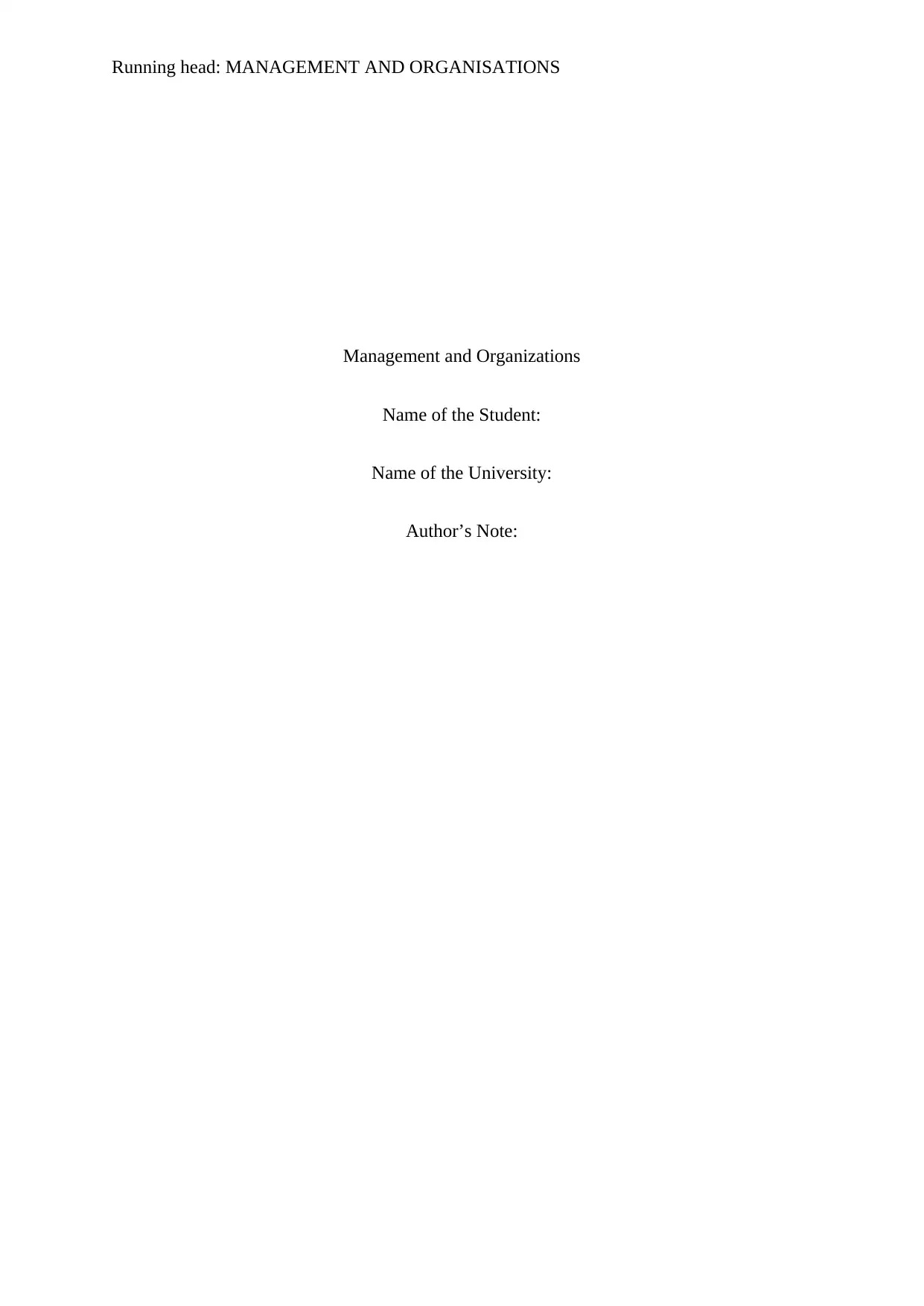
Running head: MANAGEMENT AND ORGANISATIONS
Management and Organizations
Name of the Student:
Name of the University:
Author’s Note:
Management and Organizations
Name of the Student:
Name of the University:
Author’s Note:
Paraphrase This Document
Need a fresh take? Get an instant paraphrase of this document with our AI Paraphraser
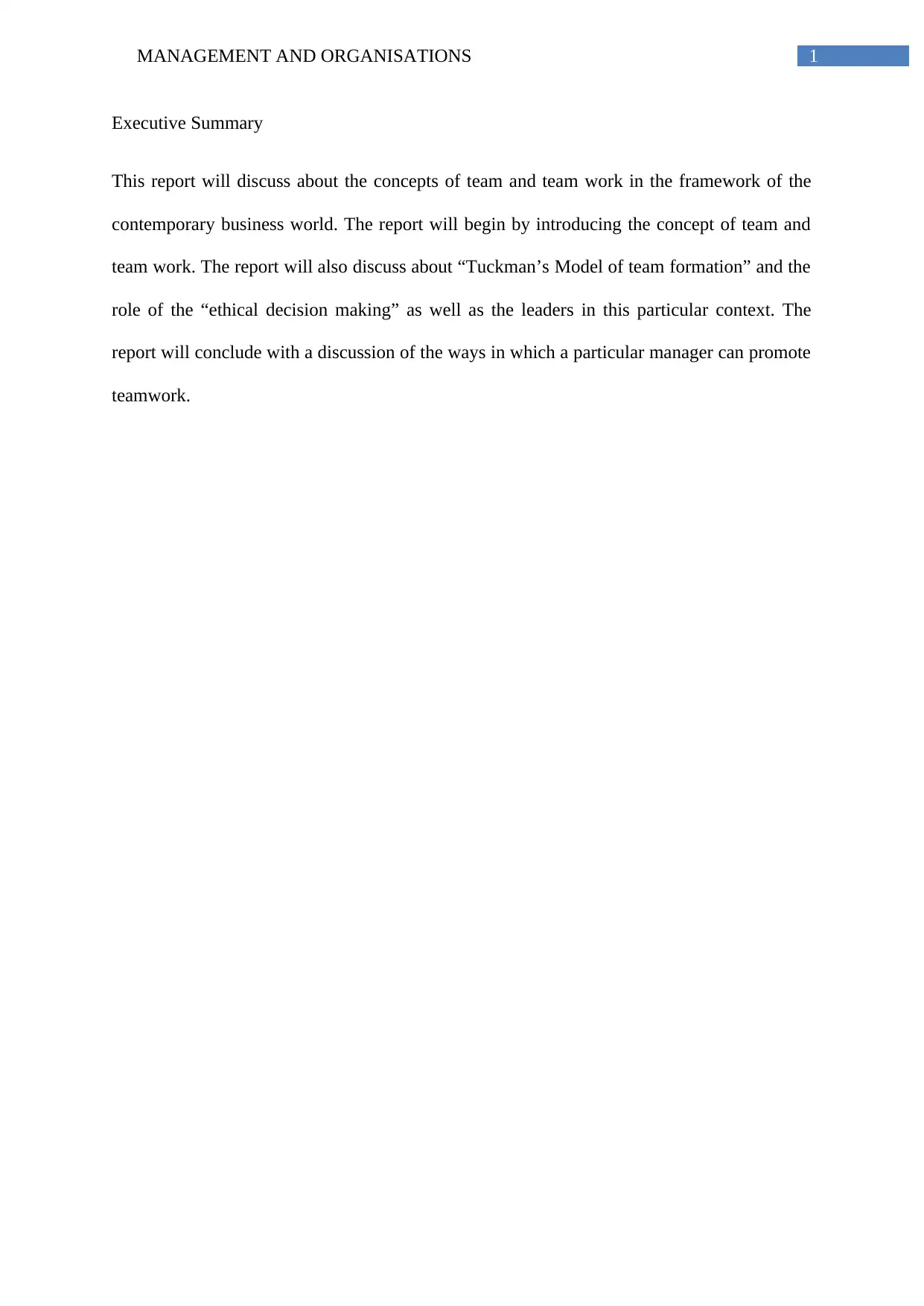
1MANAGEMENT AND ORGANISATIONS
Executive Summary
This report will discuss about the concepts of team and team work in the framework of the
contemporary business world. The report will begin by introducing the concept of team and
team work. The report will also discuss about “Tuckman’s Model of team formation” and the
role of the “ethical decision making” as well as the leaders in this particular context. The
report will conclude with a discussion of the ways in which a particular manager can promote
teamwork.
Executive Summary
This report will discuss about the concepts of team and team work in the framework of the
contemporary business world. The report will begin by introducing the concept of team and
team work. The report will also discuss about “Tuckman’s Model of team formation” and the
role of the “ethical decision making” as well as the leaders in this particular context. The
report will conclude with a discussion of the ways in which a particular manager can promote
teamwork.
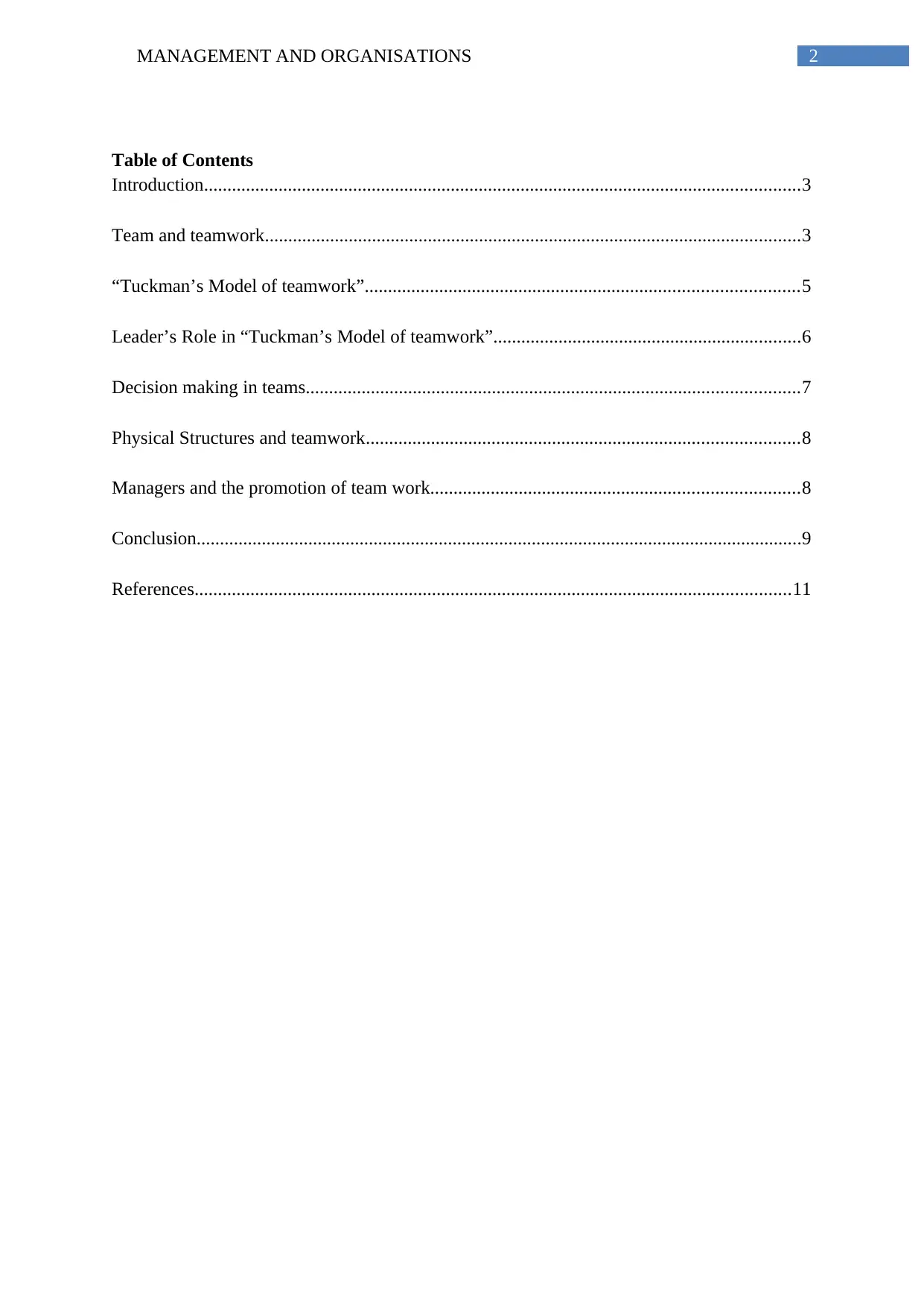
2MANAGEMENT AND ORGANISATIONS
Table of Contents
Introduction................................................................................................................................3
Team and teamwork...................................................................................................................3
“Tuckman’s Model of teamwork”.............................................................................................5
Leader’s Role in “Tuckman’s Model of teamwork”..................................................................6
Decision making in teams..........................................................................................................7
Physical Structures and teamwork.............................................................................................8
Managers and the promotion of team work...............................................................................8
Conclusion..................................................................................................................................9
References................................................................................................................................11
Table of Contents
Introduction................................................................................................................................3
Team and teamwork...................................................................................................................3
“Tuckman’s Model of teamwork”.............................................................................................5
Leader’s Role in “Tuckman’s Model of teamwork”..................................................................6
Decision making in teams..........................................................................................................7
Physical Structures and teamwork.............................................................................................8
Managers and the promotion of team work...............................................................................8
Conclusion..................................................................................................................................9
References................................................................................................................................11
⊘ This is a preview!⊘
Do you want full access?
Subscribe today to unlock all pages.

Trusted by 1+ million students worldwide
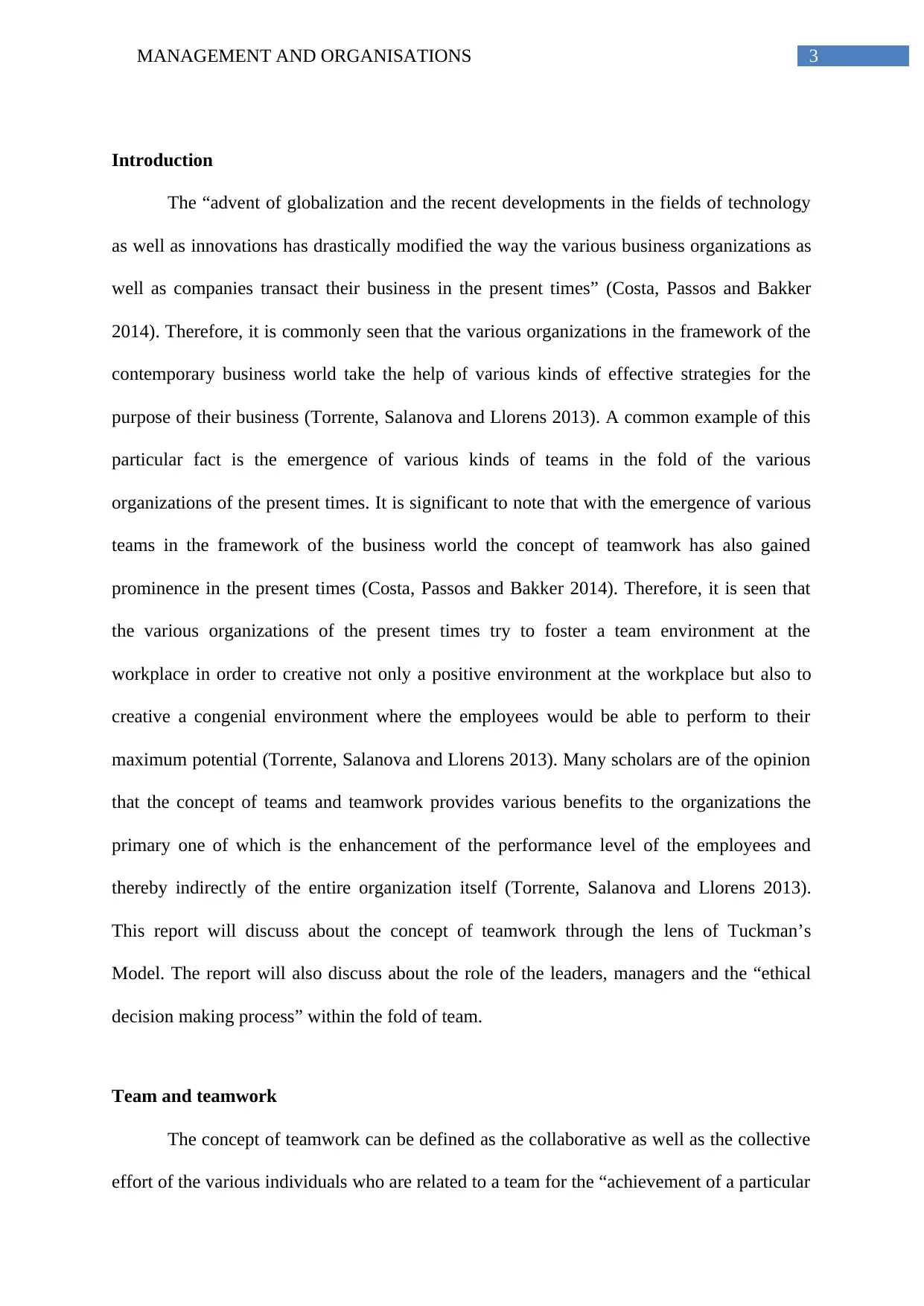
3MANAGEMENT AND ORGANISATIONS
Introduction
The “advent of globalization and the recent developments in the fields of technology
as well as innovations has drastically modified the way the various business organizations as
well as companies transact their business in the present times” (Costa, Passos and Bakker
2014). Therefore, it is commonly seen that the various organizations in the framework of the
contemporary business world take the help of various kinds of effective strategies for the
purpose of their business (Torrente, Salanova and Llorens 2013). A common example of this
particular fact is the emergence of various kinds of teams in the fold of the various
organizations of the present times. It is significant to note that with the emergence of various
teams in the framework of the business world the concept of teamwork has also gained
prominence in the present times (Costa, Passos and Bakker 2014). Therefore, it is seen that
the various organizations of the present times try to foster a team environment at the
workplace in order to creative not only a positive environment at the workplace but also to
creative a congenial environment where the employees would be able to perform to their
maximum potential (Torrente, Salanova and Llorens 2013). Many scholars are of the opinion
that the concept of teams and teamwork provides various benefits to the organizations the
primary one of which is the enhancement of the performance level of the employees and
thereby indirectly of the entire organization itself (Torrente, Salanova and Llorens 2013).
This report will discuss about the concept of teamwork through the lens of Tuckman’s
Model. The report will also discuss about the role of the leaders, managers and the “ethical
decision making process” within the fold of team.
Team and teamwork
The concept of teamwork can be defined as the collaborative as well as the collective
effort of the various individuals who are related to a team for the “achievement of a particular
Introduction
The “advent of globalization and the recent developments in the fields of technology
as well as innovations has drastically modified the way the various business organizations as
well as companies transact their business in the present times” (Costa, Passos and Bakker
2014). Therefore, it is commonly seen that the various organizations in the framework of the
contemporary business world take the help of various kinds of effective strategies for the
purpose of their business (Torrente, Salanova and Llorens 2013). A common example of this
particular fact is the emergence of various kinds of teams in the fold of the various
organizations of the present times. It is significant to note that with the emergence of various
teams in the framework of the business world the concept of teamwork has also gained
prominence in the present times (Costa, Passos and Bakker 2014). Therefore, it is seen that
the various organizations of the present times try to foster a team environment at the
workplace in order to creative not only a positive environment at the workplace but also to
creative a congenial environment where the employees would be able to perform to their
maximum potential (Torrente, Salanova and Llorens 2013). Many scholars are of the opinion
that the concept of teams and teamwork provides various benefits to the organizations the
primary one of which is the enhancement of the performance level of the employees and
thereby indirectly of the entire organization itself (Torrente, Salanova and Llorens 2013).
This report will discuss about the concept of teamwork through the lens of Tuckman’s
Model. The report will also discuss about the role of the leaders, managers and the “ethical
decision making process” within the fold of team.
Team and teamwork
The concept of teamwork can be defined as the collaborative as well as the collective
effort of the various individuals who are related to a team for the “achievement of a particular
Paraphrase This Document
Need a fresh take? Get an instant paraphrase of this document with our AI Paraphraser
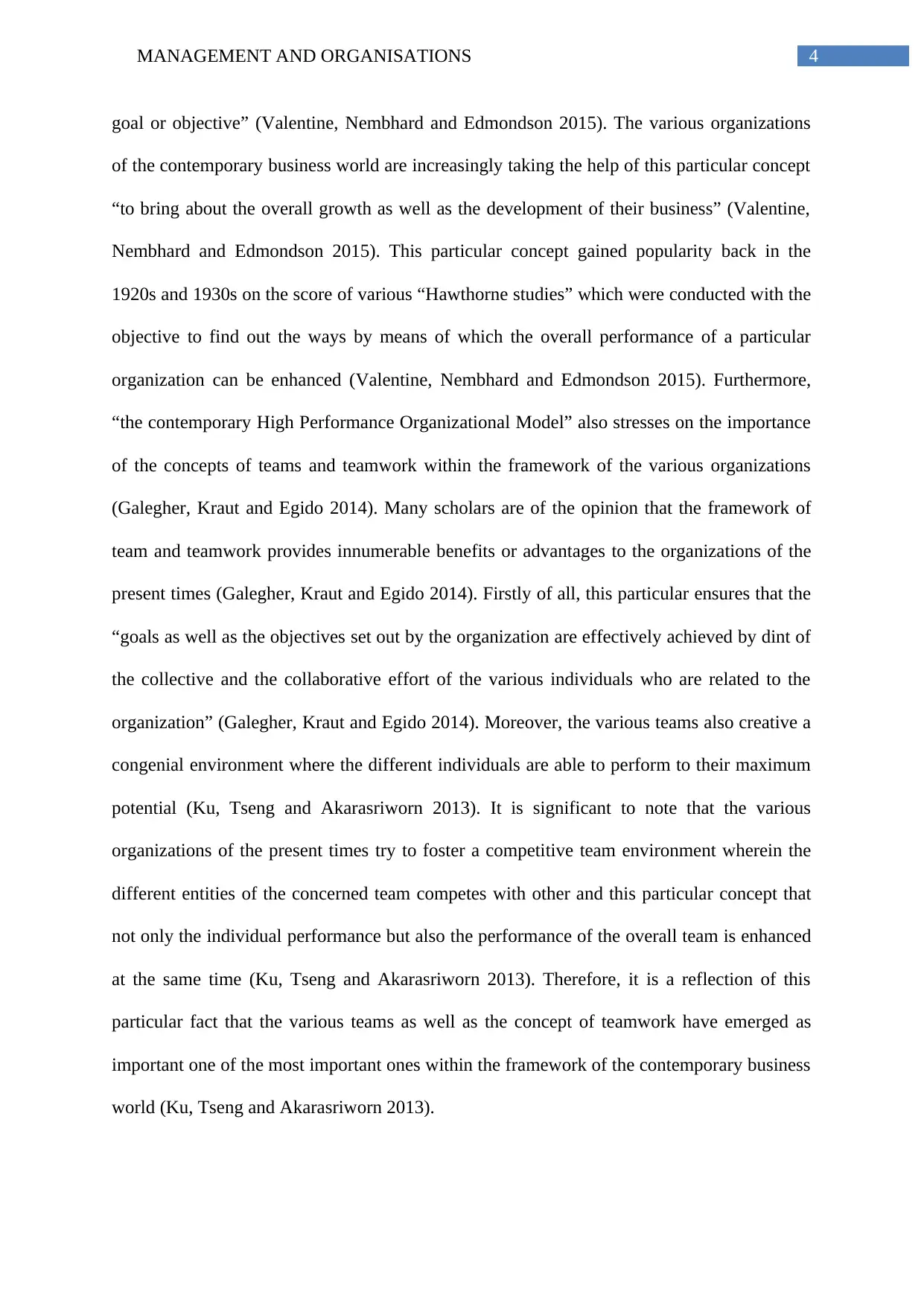
4MANAGEMENT AND ORGANISATIONS
goal or objective” (Valentine, Nembhard and Edmondson 2015). The various organizations
of the contemporary business world are increasingly taking the help of this particular concept
“to bring about the overall growth as well as the development of their business” (Valentine,
Nembhard and Edmondson 2015). This particular concept gained popularity back in the
1920s and 1930s on the score of various “Hawthorne studies” which were conducted with the
objective to find out the ways by means of which the overall performance of a particular
organization can be enhanced (Valentine, Nembhard and Edmondson 2015). Furthermore,
“the contemporary High Performance Organizational Model” also stresses on the importance
of the concepts of teams and teamwork within the framework of the various organizations
(Galegher, Kraut and Egido 2014). Many scholars are of the opinion that the framework of
team and teamwork provides innumerable benefits or advantages to the organizations of the
present times (Galegher, Kraut and Egido 2014). Firstly of all, this particular ensures that the
“goals as well as the objectives set out by the organization are effectively achieved by dint of
the collective and the collaborative effort of the various individuals who are related to the
organization” (Galegher, Kraut and Egido 2014). Moreover, the various teams also creative a
congenial environment where the different individuals are able to perform to their maximum
potential (Ku, Tseng and Akarasriworn 2013). It is significant to note that the various
organizations of the present times try to foster a competitive team environment wherein the
different entities of the concerned team competes with other and this particular concept that
not only the individual performance but also the performance of the overall team is enhanced
at the same time (Ku, Tseng and Akarasriworn 2013). Therefore, it is a reflection of this
particular fact that the various teams as well as the concept of teamwork have emerged as
important one of the most important ones within the framework of the contemporary business
world (Ku, Tseng and Akarasriworn 2013).
goal or objective” (Valentine, Nembhard and Edmondson 2015). The various organizations
of the contemporary business world are increasingly taking the help of this particular concept
“to bring about the overall growth as well as the development of their business” (Valentine,
Nembhard and Edmondson 2015). This particular concept gained popularity back in the
1920s and 1930s on the score of various “Hawthorne studies” which were conducted with the
objective to find out the ways by means of which the overall performance of a particular
organization can be enhanced (Valentine, Nembhard and Edmondson 2015). Furthermore,
“the contemporary High Performance Organizational Model” also stresses on the importance
of the concepts of teams and teamwork within the framework of the various organizations
(Galegher, Kraut and Egido 2014). Many scholars are of the opinion that the framework of
team and teamwork provides innumerable benefits or advantages to the organizations of the
present times (Galegher, Kraut and Egido 2014). Firstly of all, this particular ensures that the
“goals as well as the objectives set out by the organization are effectively achieved by dint of
the collective and the collaborative effort of the various individuals who are related to the
organization” (Galegher, Kraut and Egido 2014). Moreover, the various teams also creative a
congenial environment where the different individuals are able to perform to their maximum
potential (Ku, Tseng and Akarasriworn 2013). It is significant to note that the various
organizations of the present times try to foster a competitive team environment wherein the
different entities of the concerned team competes with other and this particular concept that
not only the individual performance but also the performance of the overall team is enhanced
at the same time (Ku, Tseng and Akarasriworn 2013). Therefore, it is a reflection of this
particular fact that the various teams as well as the concept of teamwork have emerged as
important one of the most important ones within the framework of the contemporary business
world (Ku, Tseng and Akarasriworn 2013).
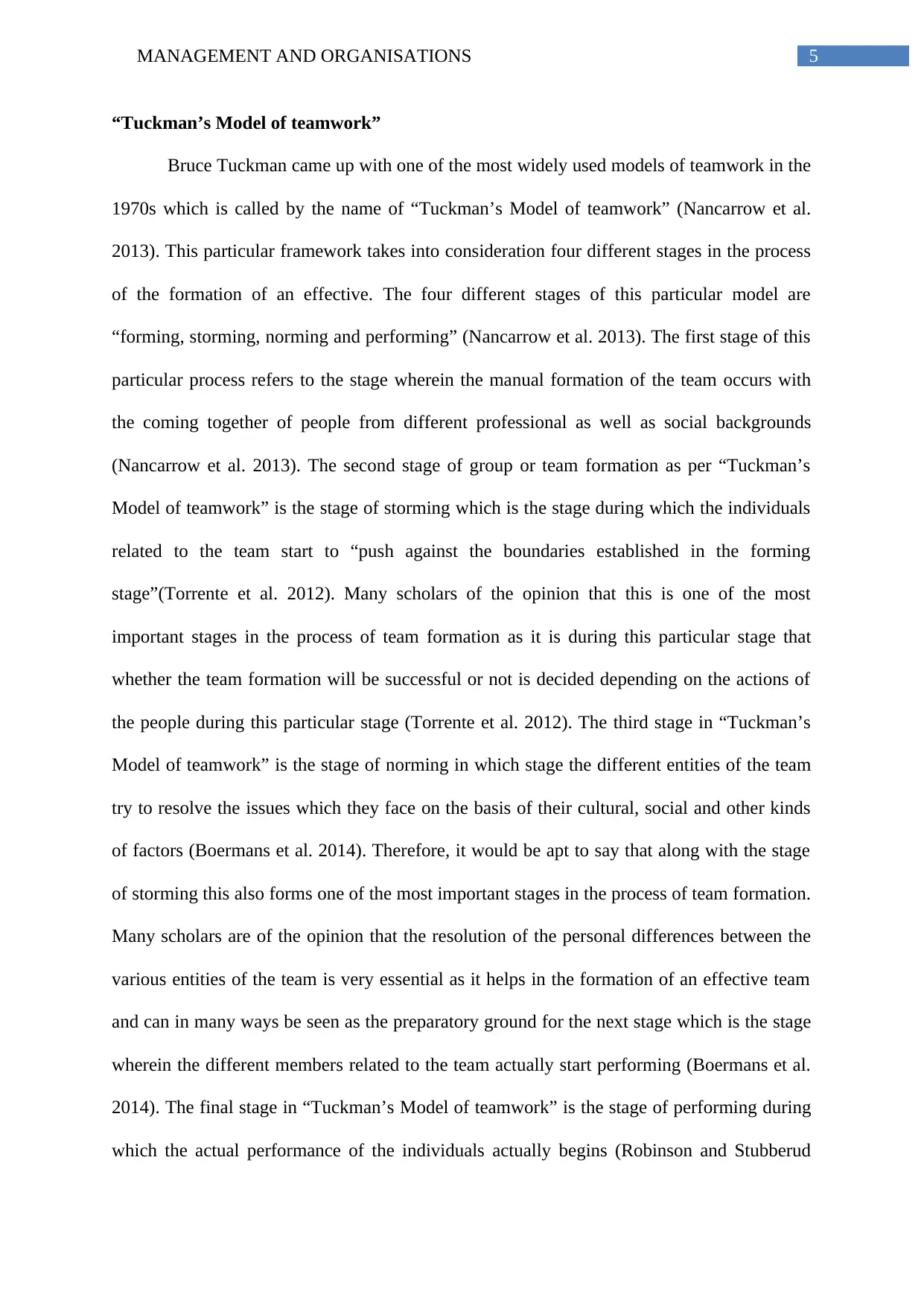
5MANAGEMENT AND ORGANISATIONS
“Tuckman’s Model of teamwork”
Bruce Tuckman came up with one of the most widely used models of teamwork in the
1970s which is called by the name of “Tuckman’s Model of teamwork” (Nancarrow et al.
2013). This particular framework takes into consideration four different stages in the process
of the formation of an effective. The four different stages of this particular model are
“forming, storming, norming and performing” (Nancarrow et al. 2013). The first stage of this
particular process refers to the stage wherein the manual formation of the team occurs with
the coming together of people from different professional as well as social backgrounds
(Nancarrow et al. 2013). The second stage of group or team formation as per “Tuckman’s
Model of teamwork” is the stage of storming which is the stage during which the individuals
related to the team start to “push against the boundaries established in the forming
stage”(Torrente et al. 2012). Many scholars of the opinion that this is one of the most
important stages in the process of team formation as it is during this particular stage that
whether the team formation will be successful or not is decided depending on the actions of
the people during this particular stage (Torrente et al. 2012). The third stage in “Tuckman’s
Model of teamwork” is the stage of norming in which stage the different entities of the team
try to resolve the issues which they face on the basis of their cultural, social and other kinds
of factors (Boermans et al. 2014). Therefore, it would be apt to say that along with the stage
of storming this also forms one of the most important stages in the process of team formation.
Many scholars are of the opinion that the resolution of the personal differences between the
various entities of the team is very essential as it helps in the formation of an effective team
and can in many ways be seen as the preparatory ground for the next stage which is the stage
wherein the different members related to the team actually start performing (Boermans et al.
2014). The final stage in “Tuckman’s Model of teamwork” is the stage of performing during
which the actual performance of the individuals actually begins (Robinson and Stubberud
“Tuckman’s Model of teamwork”
Bruce Tuckman came up with one of the most widely used models of teamwork in the
1970s which is called by the name of “Tuckman’s Model of teamwork” (Nancarrow et al.
2013). This particular framework takes into consideration four different stages in the process
of the formation of an effective. The four different stages of this particular model are
“forming, storming, norming and performing” (Nancarrow et al. 2013). The first stage of this
particular process refers to the stage wherein the manual formation of the team occurs with
the coming together of people from different professional as well as social backgrounds
(Nancarrow et al. 2013). The second stage of group or team formation as per “Tuckman’s
Model of teamwork” is the stage of storming which is the stage during which the individuals
related to the team start to “push against the boundaries established in the forming
stage”(Torrente et al. 2012). Many scholars of the opinion that this is one of the most
important stages in the process of team formation as it is during this particular stage that
whether the team formation will be successful or not is decided depending on the actions of
the people during this particular stage (Torrente et al. 2012). The third stage in “Tuckman’s
Model of teamwork” is the stage of norming in which stage the different entities of the team
try to resolve the issues which they face on the basis of their cultural, social and other kinds
of factors (Boermans et al. 2014). Therefore, it would be apt to say that along with the stage
of storming this also forms one of the most important stages in the process of team formation.
Many scholars are of the opinion that the resolution of the personal differences between the
various entities of the team is very essential as it helps in the formation of an effective team
and can in many ways be seen as the preparatory ground for the next stage which is the stage
wherein the different members related to the team actually start performing (Boermans et al.
2014). The final stage in “Tuckman’s Model of teamwork” is the stage of performing during
which the actual performance of the individuals actually begins (Robinson and Stubberud
⊘ This is a preview!⊘
Do you want full access?
Subscribe today to unlock all pages.

Trusted by 1+ million students worldwide
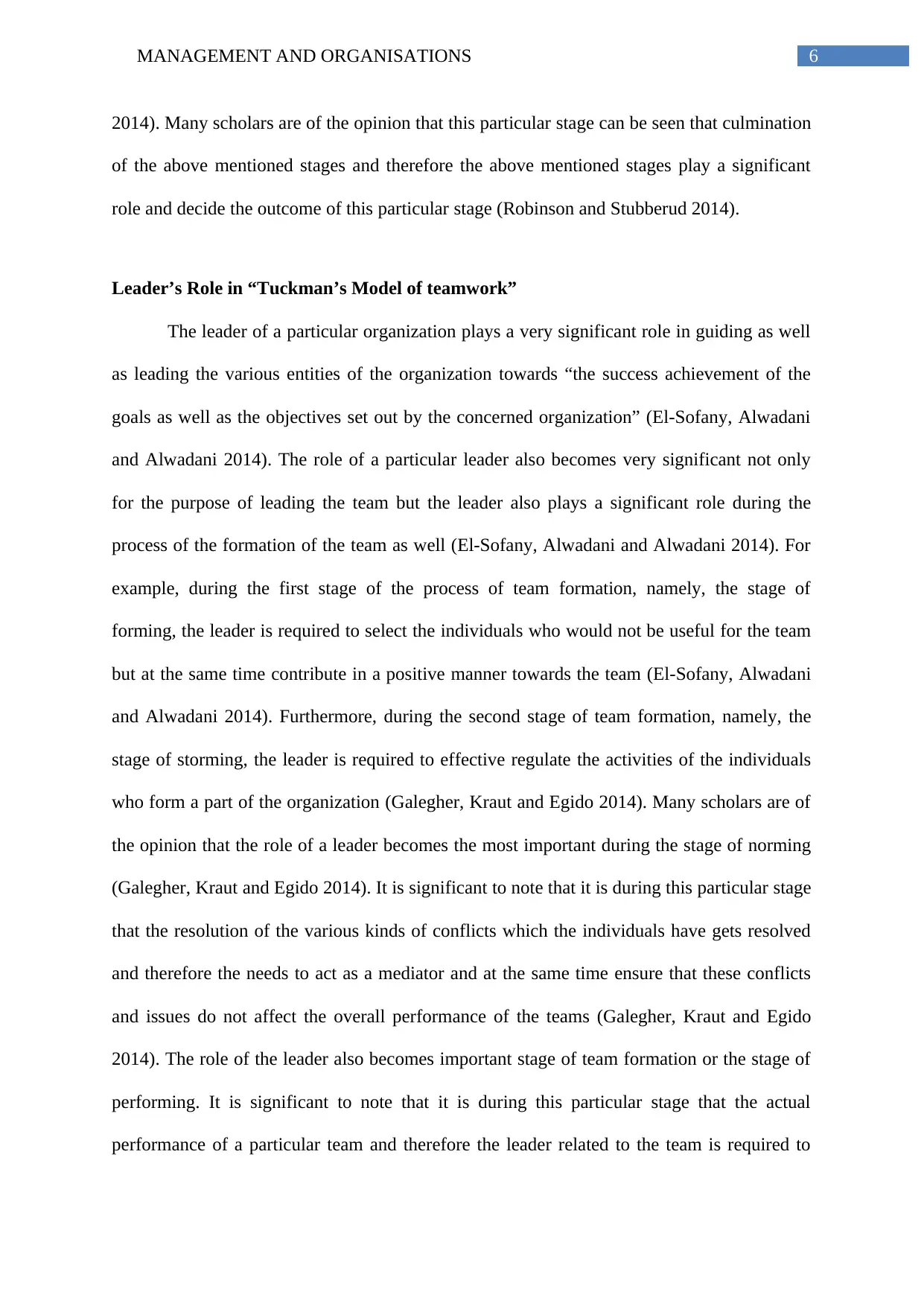
6MANAGEMENT AND ORGANISATIONS
2014). Many scholars are of the opinion that this particular stage can be seen that culmination
of the above mentioned stages and therefore the above mentioned stages play a significant
role and decide the outcome of this particular stage (Robinson and Stubberud 2014).
Leader’s Role in “Tuckman’s Model of teamwork”
The leader of a particular organization plays a very significant role in guiding as well
as leading the various entities of the organization towards “the success achievement of the
goals as well as the objectives set out by the concerned organization” (El-Sofany, Alwadani
and Alwadani 2014). The role of a particular leader also becomes very significant not only
for the purpose of leading the team but the leader also plays a significant role during the
process of the formation of the team as well (El-Sofany, Alwadani and Alwadani 2014). For
example, during the first stage of the process of team formation, namely, the stage of
forming, the leader is required to select the individuals who would not be useful for the team
but at the same time contribute in a positive manner towards the team (El-Sofany, Alwadani
and Alwadani 2014). Furthermore, during the second stage of team formation, namely, the
stage of storming, the leader is required to effective regulate the activities of the individuals
who form a part of the organization (Galegher, Kraut and Egido 2014). Many scholars are of
the opinion that the role of a leader becomes the most important during the stage of norming
(Galegher, Kraut and Egido 2014). It is significant to note that it is during this particular stage
that the resolution of the various kinds of conflicts which the individuals have gets resolved
and therefore the needs to act as a mediator and at the same time ensure that these conflicts
and issues do not affect the overall performance of the teams (Galegher, Kraut and Egido
2014). The role of the leader also becomes important stage of team formation or the stage of
performing. It is significant to note that it is during this particular stage that the actual
performance of a particular team and therefore the leader related to the team is required to
2014). Many scholars are of the opinion that this particular stage can be seen that culmination
of the above mentioned stages and therefore the above mentioned stages play a significant
role and decide the outcome of this particular stage (Robinson and Stubberud 2014).
Leader’s Role in “Tuckman’s Model of teamwork”
The leader of a particular organization plays a very significant role in guiding as well
as leading the various entities of the organization towards “the success achievement of the
goals as well as the objectives set out by the concerned organization” (El-Sofany, Alwadani
and Alwadani 2014). The role of a particular leader also becomes very significant not only
for the purpose of leading the team but the leader also plays a significant role during the
process of the formation of the team as well (El-Sofany, Alwadani and Alwadani 2014). For
example, during the first stage of the process of team formation, namely, the stage of
forming, the leader is required to select the individuals who would not be useful for the team
but at the same time contribute in a positive manner towards the team (El-Sofany, Alwadani
and Alwadani 2014). Furthermore, during the second stage of team formation, namely, the
stage of storming, the leader is required to effective regulate the activities of the individuals
who form a part of the organization (Galegher, Kraut and Egido 2014). Many scholars are of
the opinion that the role of a leader becomes the most important during the stage of norming
(Galegher, Kraut and Egido 2014). It is significant to note that it is during this particular stage
that the resolution of the various kinds of conflicts which the individuals have gets resolved
and therefore the needs to act as a mediator and at the same time ensure that these conflicts
and issues do not affect the overall performance of the teams (Galegher, Kraut and Egido
2014). The role of the leader also becomes important stage of team formation or the stage of
performing. It is significant to note that it is during this particular stage that the actual
performance of a particular team and therefore the leader related to the team is required to
Paraphrase This Document
Need a fresh take? Get an instant paraphrase of this document with our AI Paraphraser
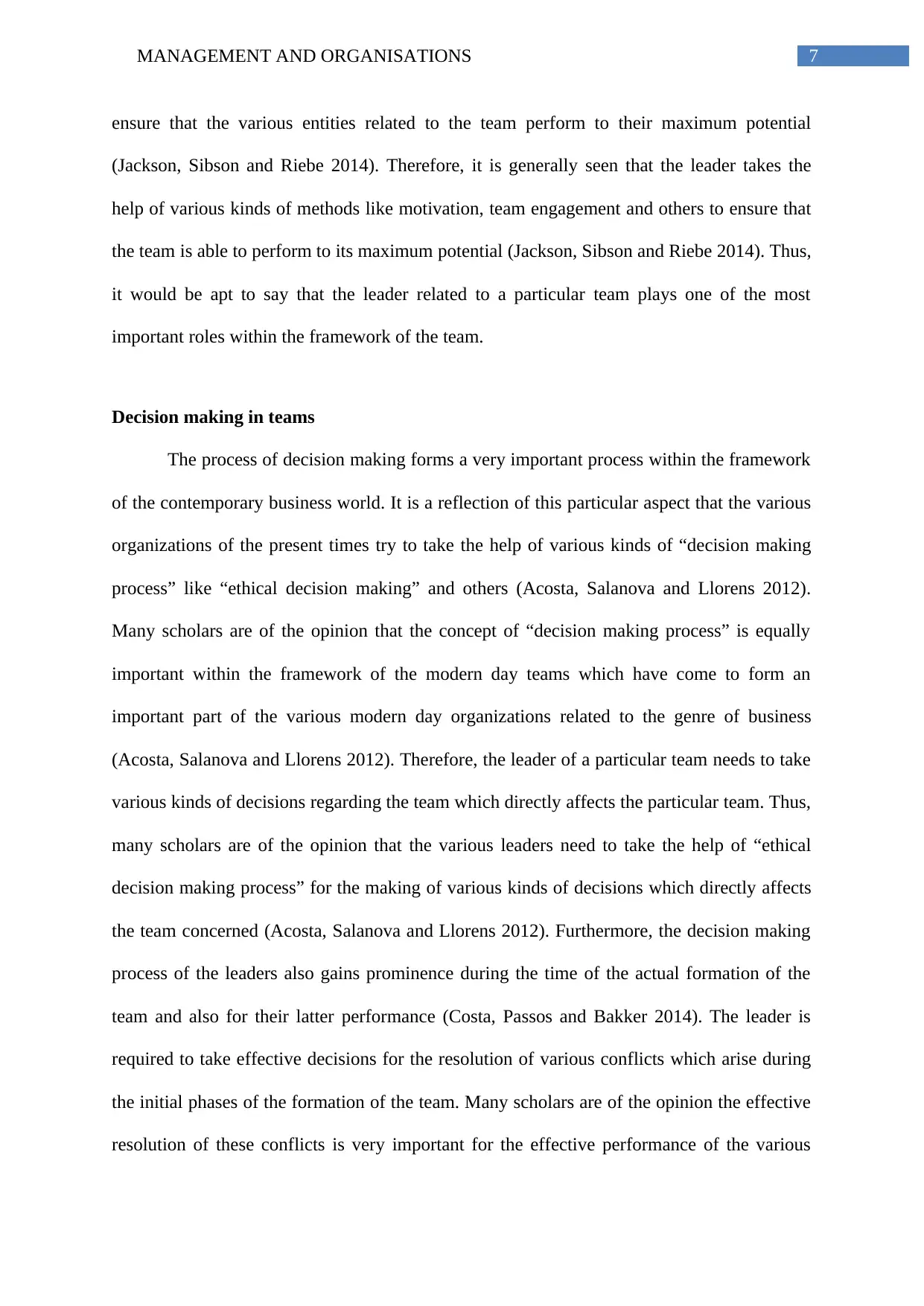
7MANAGEMENT AND ORGANISATIONS
ensure that the various entities related to the team perform to their maximum potential
(Jackson, Sibson and Riebe 2014). Therefore, it is generally seen that the leader takes the
help of various kinds of methods like motivation, team engagement and others to ensure that
the team is able to perform to its maximum potential (Jackson, Sibson and Riebe 2014). Thus,
it would be apt to say that the leader related to a particular team plays one of the most
important roles within the framework of the team.
Decision making in teams
The process of decision making forms a very important process within the framework
of the contemporary business world. It is a reflection of this particular aspect that the various
organizations of the present times try to take the help of various kinds of “decision making
process” like “ethical decision making” and others (Acosta, Salanova and Llorens 2012).
Many scholars are of the opinion that the concept of “decision making process” is equally
important within the framework of the modern day teams which have come to form an
important part of the various modern day organizations related to the genre of business
(Acosta, Salanova and Llorens 2012). Therefore, the leader of a particular team needs to take
various kinds of decisions regarding the team which directly affects the particular team. Thus,
many scholars are of the opinion that the various leaders need to take the help of “ethical
decision making process” for the making of various kinds of decisions which directly affects
the team concerned (Acosta, Salanova and Llorens 2012). Furthermore, the decision making
process of the leaders also gains prominence during the time of the actual formation of the
team and also for their latter performance (Costa, Passos and Bakker 2014). The leader is
required to take effective decisions for the resolution of various conflicts which arise during
the initial phases of the formation of the team. Many scholars are of the opinion the effective
resolution of these conflicts is very important for the effective performance of the various
ensure that the various entities related to the team perform to their maximum potential
(Jackson, Sibson and Riebe 2014). Therefore, it is generally seen that the leader takes the
help of various kinds of methods like motivation, team engagement and others to ensure that
the team is able to perform to its maximum potential (Jackson, Sibson and Riebe 2014). Thus,
it would be apt to say that the leader related to a particular team plays one of the most
important roles within the framework of the team.
Decision making in teams
The process of decision making forms a very important process within the framework
of the contemporary business world. It is a reflection of this particular aspect that the various
organizations of the present times try to take the help of various kinds of “decision making
process” like “ethical decision making” and others (Acosta, Salanova and Llorens 2012).
Many scholars are of the opinion that the concept of “decision making process” is equally
important within the framework of the modern day teams which have come to form an
important part of the various modern day organizations related to the genre of business
(Acosta, Salanova and Llorens 2012). Therefore, the leader of a particular team needs to take
various kinds of decisions regarding the team which directly affects the particular team. Thus,
many scholars are of the opinion that the various leaders need to take the help of “ethical
decision making process” for the making of various kinds of decisions which directly affects
the team concerned (Acosta, Salanova and Llorens 2012). Furthermore, the decision making
process of the leaders also gains prominence during the time of the actual formation of the
team and also for their latter performance (Costa, Passos and Bakker 2014). The leader is
required to take effective decisions for the resolution of various conflicts which arise during
the initial phases of the formation of the team. Many scholars are of the opinion the effective
resolution of these conflicts is very important for the effective performance of the various
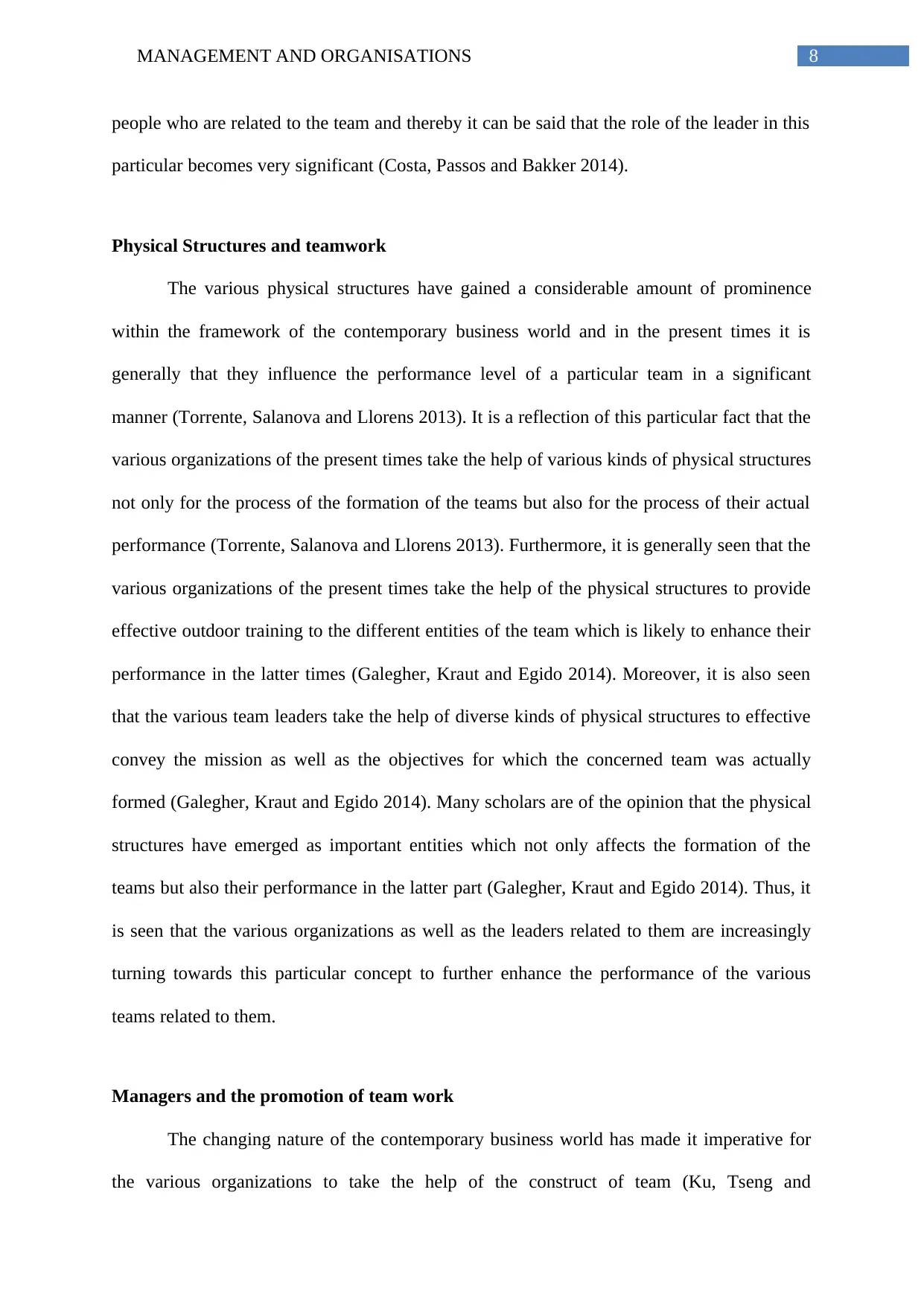
8MANAGEMENT AND ORGANISATIONS
people who are related to the team and thereby it can be said that the role of the leader in this
particular becomes very significant (Costa, Passos and Bakker 2014).
Physical Structures and teamwork
The various physical structures have gained a considerable amount of prominence
within the framework of the contemporary business world and in the present times it is
generally that they influence the performance level of a particular team in a significant
manner (Torrente, Salanova and Llorens 2013). It is a reflection of this particular fact that the
various organizations of the present times take the help of various kinds of physical structures
not only for the process of the formation of the teams but also for the process of their actual
performance (Torrente, Salanova and Llorens 2013). Furthermore, it is generally seen that the
various organizations of the present times take the help of the physical structures to provide
effective outdoor training to the different entities of the team which is likely to enhance their
performance in the latter times (Galegher, Kraut and Egido 2014). Moreover, it is also seen
that the various team leaders take the help of diverse kinds of physical structures to effective
convey the mission as well as the objectives for which the concerned team was actually
formed (Galegher, Kraut and Egido 2014). Many scholars are of the opinion that the physical
structures have emerged as important entities which not only affects the formation of the
teams but also their performance in the latter part (Galegher, Kraut and Egido 2014). Thus, it
is seen that the various organizations as well as the leaders related to them are increasingly
turning towards this particular concept to further enhance the performance of the various
teams related to them.
Managers and the promotion of team work
The changing nature of the contemporary business world has made it imperative for
the various organizations to take the help of the construct of team (Ku, Tseng and
people who are related to the team and thereby it can be said that the role of the leader in this
particular becomes very significant (Costa, Passos and Bakker 2014).
Physical Structures and teamwork
The various physical structures have gained a considerable amount of prominence
within the framework of the contemporary business world and in the present times it is
generally that they influence the performance level of a particular team in a significant
manner (Torrente, Salanova and Llorens 2013). It is a reflection of this particular fact that the
various organizations of the present times take the help of various kinds of physical structures
not only for the process of the formation of the teams but also for the process of their actual
performance (Torrente, Salanova and Llorens 2013). Furthermore, it is generally seen that the
various organizations of the present times take the help of the physical structures to provide
effective outdoor training to the different entities of the team which is likely to enhance their
performance in the latter times (Galegher, Kraut and Egido 2014). Moreover, it is also seen
that the various team leaders take the help of diverse kinds of physical structures to effective
convey the mission as well as the objectives for which the concerned team was actually
formed (Galegher, Kraut and Egido 2014). Many scholars are of the opinion that the physical
structures have emerged as important entities which not only affects the formation of the
teams but also their performance in the latter part (Galegher, Kraut and Egido 2014). Thus, it
is seen that the various organizations as well as the leaders related to them are increasingly
turning towards this particular concept to further enhance the performance of the various
teams related to them.
Managers and the promotion of team work
The changing nature of the contemporary business world has made it imperative for
the various organizations to take the help of the construct of team (Ku, Tseng and
⊘ This is a preview!⊘
Do you want full access?
Subscribe today to unlock all pages.

Trusted by 1+ million students worldwide
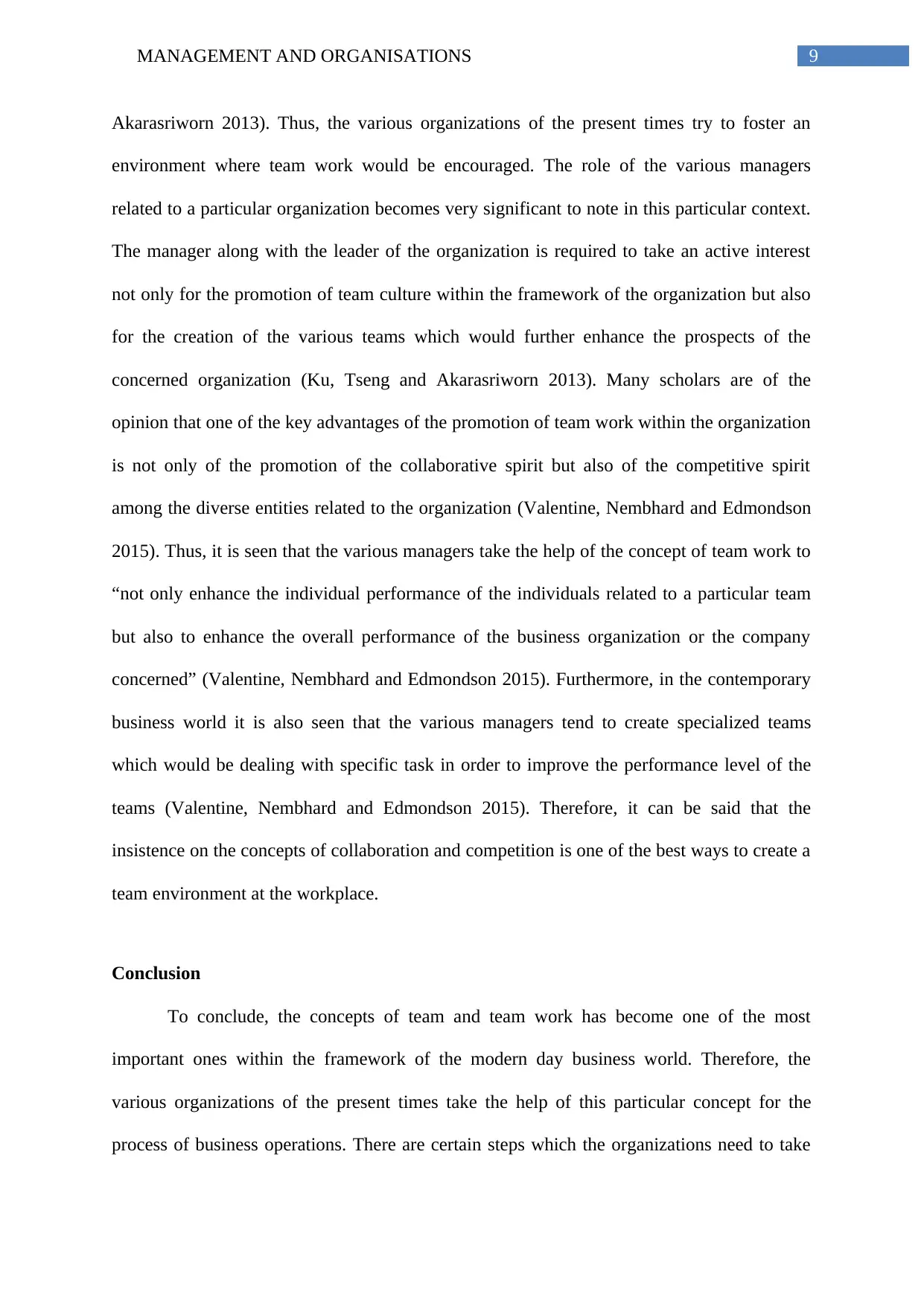
9MANAGEMENT AND ORGANISATIONS
Akarasriworn 2013). Thus, the various organizations of the present times try to foster an
environment where team work would be encouraged. The role of the various managers
related to a particular organization becomes very significant to note in this particular context.
The manager along with the leader of the organization is required to take an active interest
not only for the promotion of team culture within the framework of the organization but also
for the creation of the various teams which would further enhance the prospects of the
concerned organization (Ku, Tseng and Akarasriworn 2013). Many scholars are of the
opinion that one of the key advantages of the promotion of team work within the organization
is not only of the promotion of the collaborative spirit but also of the competitive spirit
among the diverse entities related to the organization (Valentine, Nembhard and Edmondson
2015). Thus, it is seen that the various managers take the help of the concept of team work to
“not only enhance the individual performance of the individuals related to a particular team
but also to enhance the overall performance of the business organization or the company
concerned” (Valentine, Nembhard and Edmondson 2015). Furthermore, in the contemporary
business world it is also seen that the various managers tend to create specialized teams
which would be dealing with specific task in order to improve the performance level of the
teams (Valentine, Nembhard and Edmondson 2015). Therefore, it can be said that the
insistence on the concepts of collaboration and competition is one of the best ways to create a
team environment at the workplace.
Conclusion
To conclude, the concepts of team and team work has become one of the most
important ones within the framework of the modern day business world. Therefore, the
various organizations of the present times take the help of this particular concept for the
process of business operations. There are certain steps which the organizations need to take
Akarasriworn 2013). Thus, the various organizations of the present times try to foster an
environment where team work would be encouraged. The role of the various managers
related to a particular organization becomes very significant to note in this particular context.
The manager along with the leader of the organization is required to take an active interest
not only for the promotion of team culture within the framework of the organization but also
for the creation of the various teams which would further enhance the prospects of the
concerned organization (Ku, Tseng and Akarasriworn 2013). Many scholars are of the
opinion that one of the key advantages of the promotion of team work within the organization
is not only of the promotion of the collaborative spirit but also of the competitive spirit
among the diverse entities related to the organization (Valentine, Nembhard and Edmondson
2015). Thus, it is seen that the various managers take the help of the concept of team work to
“not only enhance the individual performance of the individuals related to a particular team
but also to enhance the overall performance of the business organization or the company
concerned” (Valentine, Nembhard and Edmondson 2015). Furthermore, in the contemporary
business world it is also seen that the various managers tend to create specialized teams
which would be dealing with specific task in order to improve the performance level of the
teams (Valentine, Nembhard and Edmondson 2015). Therefore, it can be said that the
insistence on the concepts of collaboration and competition is one of the best ways to create a
team environment at the workplace.
Conclusion
To conclude, the concepts of team and team work has become one of the most
important ones within the framework of the modern day business world. Therefore, the
various organizations of the present times take the help of this particular concept for the
process of business operations. There are certain steps which the organizations need to take
Paraphrase This Document
Need a fresh take? Get an instant paraphrase of this document with our AI Paraphraser
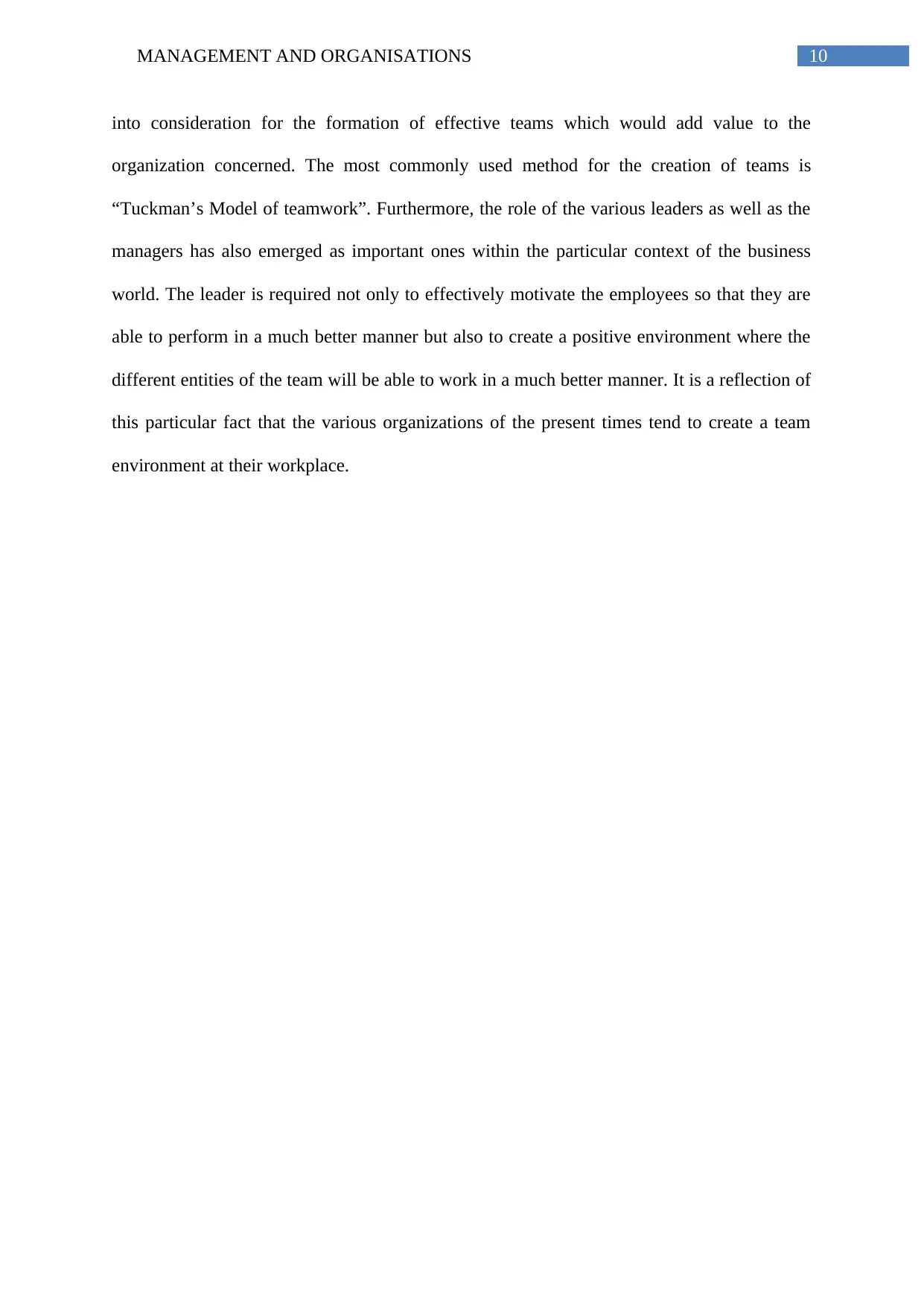
10MANAGEMENT AND ORGANISATIONS
into consideration for the formation of effective teams which would add value to the
organization concerned. The most commonly used method for the creation of teams is
“Tuckman’s Model of teamwork”. Furthermore, the role of the various leaders as well as the
managers has also emerged as important ones within the particular context of the business
world. The leader is required not only to effectively motivate the employees so that they are
able to perform in a much better manner but also to create a positive environment where the
different entities of the team will be able to work in a much better manner. It is a reflection of
this particular fact that the various organizations of the present times tend to create a team
environment at their workplace.
into consideration for the formation of effective teams which would add value to the
organization concerned. The most commonly used method for the creation of teams is
“Tuckman’s Model of teamwork”. Furthermore, the role of the various leaders as well as the
managers has also emerged as important ones within the particular context of the business
world. The leader is required not only to effectively motivate the employees so that they are
able to perform in a much better manner but also to create a positive environment where the
different entities of the team will be able to work in a much better manner. It is a reflection of
this particular fact that the various organizations of the present times tend to create a team
environment at their workplace.
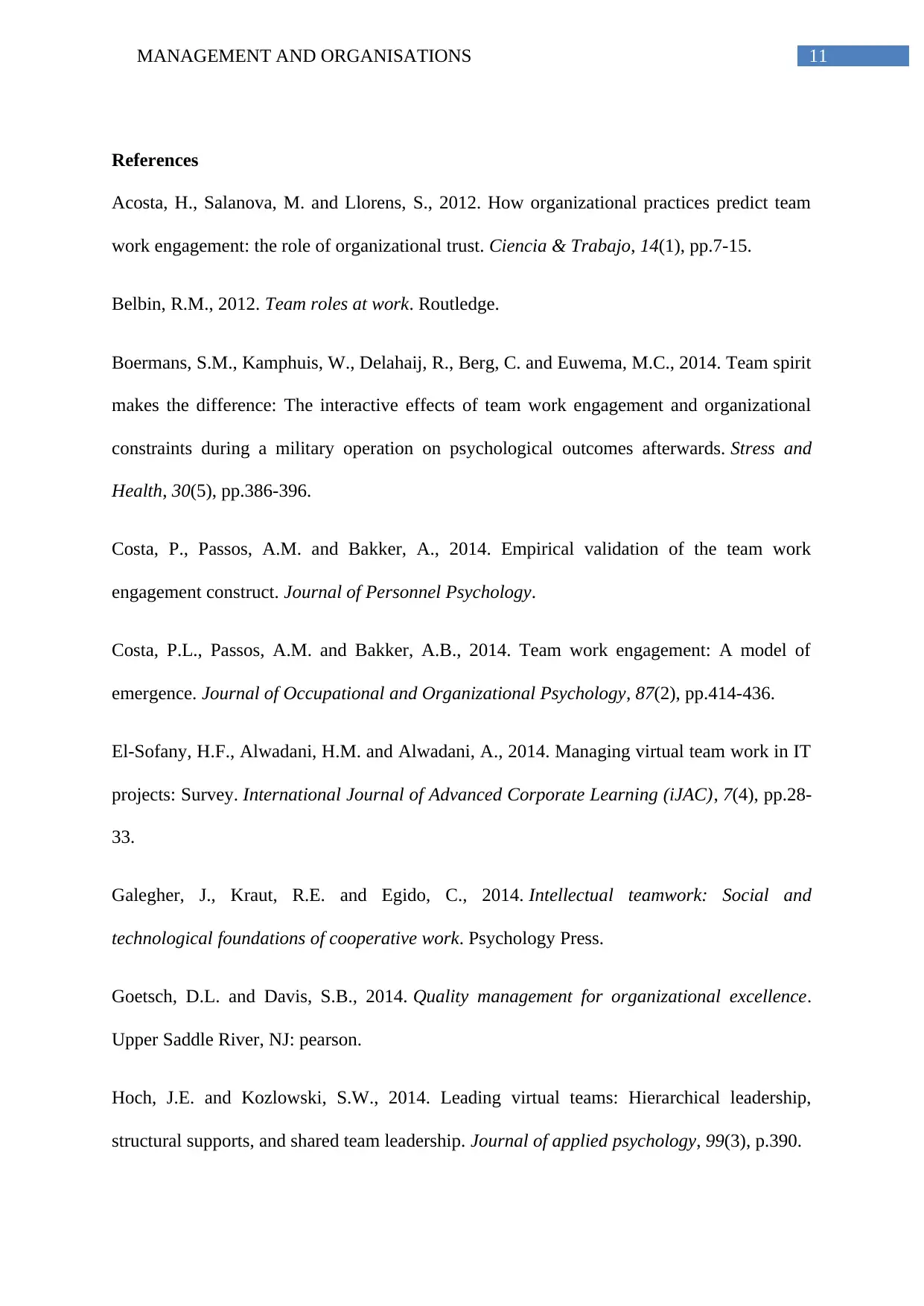
11MANAGEMENT AND ORGANISATIONS
References
Acosta, H., Salanova, M. and Llorens, S., 2012. How organizational practices predict team
work engagement: the role of organizational trust. Ciencia & Trabajo, 14(1), pp.7-15.
Belbin, R.M., 2012. Team roles at work. Routledge.
Boermans, S.M., Kamphuis, W., Delahaij, R., Berg, C. and Euwema, M.C., 2014. Team spirit
makes the difference: The interactive effects of team work engagement and organizational
constraints during a military operation on psychological outcomes afterwards. Stress and
Health, 30(5), pp.386-396.
Costa, P., Passos, A.M. and Bakker, A., 2014. Empirical validation of the team work
engagement construct. Journal of Personnel Psychology.
Costa, P.L., Passos, A.M. and Bakker, A.B., 2014. Team work engagement: A model of
emergence. Journal of Occupational and Organizational Psychology, 87(2), pp.414-436.
El-Sofany, H.F., Alwadani, H.M. and Alwadani, A., 2014. Managing virtual team work in IT
projects: Survey. International Journal of Advanced Corporate Learning (iJAC), 7(4), pp.28-
33.
Galegher, J., Kraut, R.E. and Egido, C., 2014. Intellectual teamwork: Social and
technological foundations of cooperative work. Psychology Press.
Goetsch, D.L. and Davis, S.B., 2014. Quality management for organizational excellence.
Upper Saddle River, NJ: pearson.
Hoch, J.E. and Kozlowski, S.W., 2014. Leading virtual teams: Hierarchical leadership,
structural supports, and shared team leadership. Journal of applied psychology, 99(3), p.390.
References
Acosta, H., Salanova, M. and Llorens, S., 2012. How organizational practices predict team
work engagement: the role of organizational trust. Ciencia & Trabajo, 14(1), pp.7-15.
Belbin, R.M., 2012. Team roles at work. Routledge.
Boermans, S.M., Kamphuis, W., Delahaij, R., Berg, C. and Euwema, M.C., 2014. Team spirit
makes the difference: The interactive effects of team work engagement and organizational
constraints during a military operation on psychological outcomes afterwards. Stress and
Health, 30(5), pp.386-396.
Costa, P., Passos, A.M. and Bakker, A., 2014. Empirical validation of the team work
engagement construct. Journal of Personnel Psychology.
Costa, P.L., Passos, A.M. and Bakker, A.B., 2014. Team work engagement: A model of
emergence. Journal of Occupational and Organizational Psychology, 87(2), pp.414-436.
El-Sofany, H.F., Alwadani, H.M. and Alwadani, A., 2014. Managing virtual team work in IT
projects: Survey. International Journal of Advanced Corporate Learning (iJAC), 7(4), pp.28-
33.
Galegher, J., Kraut, R.E. and Egido, C., 2014. Intellectual teamwork: Social and
technological foundations of cooperative work. Psychology Press.
Goetsch, D.L. and Davis, S.B., 2014. Quality management for organizational excellence.
Upper Saddle River, NJ: pearson.
Hoch, J.E. and Kozlowski, S.W., 2014. Leading virtual teams: Hierarchical leadership,
structural supports, and shared team leadership. Journal of applied psychology, 99(3), p.390.
⊘ This is a preview!⊘
Do you want full access?
Subscribe today to unlock all pages.

Trusted by 1+ million students worldwide
1 out of 14
Related Documents
Your All-in-One AI-Powered Toolkit for Academic Success.
+13062052269
info@desklib.com
Available 24*7 on WhatsApp / Email
![[object Object]](/_next/static/media/star-bottom.7253800d.svg)
Unlock your academic potential
Copyright © 2020–2025 A2Z Services. All Rights Reserved. Developed and managed by ZUCOL.




